Retesting the ASUS Rampage IV Black Edition Audio and the Pitfalls of Audio Testing
by Ian Cutress on January 31, 2014 4:45 AM EST- Posted in
- Motherboards
- Asus
- Audio
- Audio Precision

In the motherboard section of AnandTech, we rarely touched the audio section of the motherboard until fairly recently. Audio is a delicate issue, and knowledge on the subject falls into a wide range from the tone deaf all the way to the hyper enthusiast. Professional and prosumer audio equipment can be honed to perfection and cost an appropriate amount, where discussion on quality over $10k per meter cables can happen. It is very hard to quantify an audio experience into a single set of rules, but as the motherboard arena can feature rather elaborate audio setups designed to enhance the quality or provide sufficient electrical filtering, and that these can be some of the major selling points, several of our readers asked us to start testing the audio.
To put this into perspective, a motherboard manufacturer can create an audio portion of the motherboard that costs $2 to buy and implement. Another manufacturer will spend $20 to get a better audio codec and DAC, better audio filters, headphone amplifiers, and specifically separate the digital and audio traces on the motherboard as to reduce potential sources of interference, as well as focusing on a single output to achieve all this. Part of testing these scenarios is producing such a test that a reader can relate to, as well as a series of numbers for comparison to put in the review – both manufacturers and readers want to see that their hard earned engineering money and effort went into something that can be compared.
In light of this request to test audio, looking into the best way to test it is a minefield. The correct equipment in order to get an accurate test of dynamic range, noise and distortion costs over $10k – for example, the audio equipment used in Chris Heinonen’s recent foray into smartphone audio testing was an Audio Precision APx582, which starts at eleven thousand. Audio Precision is often cited as the company that all audio manufacturers go to in order to test their hardware. Unfortunately unlike Chris I am not able to source Audio Precision testing equipment due to my location and contacts, but having the hardware on hand takes everything out of the equation except the audio generator and filtering pathway that a manufacturer decides to use.
One ‘quick and easy’ test that has been in the mix and in several press pack guides is Rightmark: Audio Analyzer (RM:AA). This is a software solution to what is ultimately a hardware problem, and relies on the same hardware doing both the signal production and the signal receiving. This causes a number of issues, such as channel leakage, harmonic resonance in adjacent signals and that the limiting factor of the hardware being testing might affect other parts of the test. More often than not it is also difficult to compare results between products, due to input levels and driver settings. In order to provide accurate and comparable results, the software has to be explicitly set up for consistency and comparison, something a lot of reviewers that use RM:AA do not do.
I must confess that for a while I was in this crowd. My RM:AA test was ultimately out of the box and produced wildly conflicting results. When audio solutions were quoted as 108 dB for signal-to-noise ratio were getting 92 dB, the conclusions were along the lines of differences in signaling and manufacture of the motherboard. In reality, the test was very wrong – the OS by default limits input/output to 16-bit + 44.1 kHz, producing an artificial ceiling, and the volume ratio of output/input in the testing loop was not standardized. While I kept the input/output the same, in fact each output of the audio jacks can have different responses to the audio in question.
After delving further into the topic, we standardized the RM:AA test at AnandTech. The OS is now set to 24-bit, 192 kHz input and output (or the highest possible based on the audio codec options), the output volume was set to 100% and the input volume adjusted to provide accurate results without over-distorting the input. Ultimately our testing is still limited to the level of the input on the codec, often cited around 104 dB SNR compared to a 108 dB or 112 dB peak output, depending on what audio codec + DAC are used. Even when the same 3.5mm shielded cable is used or different tests, cable losses in a uncontrolled environment can be excessive (1-2 dB SNR), and my location next to a busy main road might also introduce error.
This test is in no way perfect – we typically quote the SNR and THD+N (Total Harmonic Distortion + Noise) results as these were ultimately relevant to those who wanted cleaner and louder output, rather than a quality control test.
Recently we tested the ASUS Rampage IV Black Edition. In this review, we noted that for ASUS’ audio solution, they used their SupremeFX technology – a shielded audio codec with separated tracing, audio filters, headphone amplifiers and gold plated connectors. In this, ASUS use a Realtek audio codec to power a Cirrus Logic DAC, rated at 120 dB SNR and -107 dB THD+N. Our results were well below this in terms of SNR, ~95 dB, which is substantially lower. At the time I was unsure of the reason, and needless to say ASUS got back to me to confirm my testing methodology.
After retests on my end, and a more professional test from ASUS, we exchanged new numbers for comparison. My initial numbers were indeed erroneous. After retesting, the ASUS Rampage IV Black Edition falls in the middle of the pack:
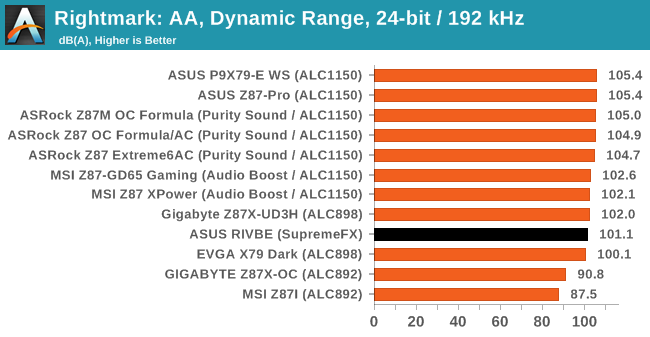
ASUS and I compared our SNR graphs to see the differences:
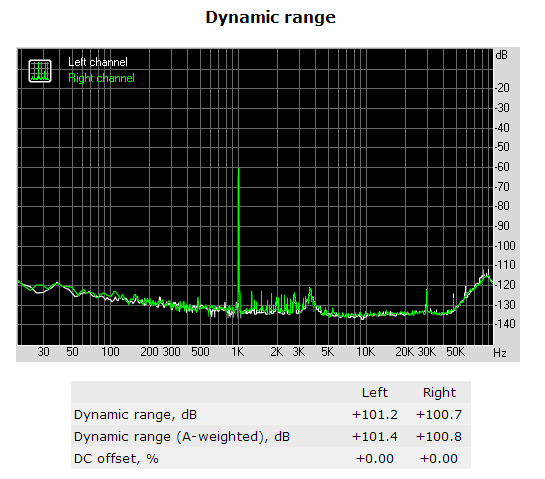
ASUS achieve a -108 dB SNR compared to my -101 dB SNR result due to ASUS using Audio Precision testing tools and my test using the Line In + RMAA methodology. The RMAA test also relies on a 1 kHz pulse at -60 dB for its test rather than a range of frequencies, which as a result causes the peak seen at 1 kHz.
In light of the discrepancy, we are coming to a fork in the road for audio testing. I fall wholeheartedly into the ‘tone deaf’ part of the crowd when it comes to analyzing audio and prefer an easy-to-read number as a comparison, although I understand this is not the be-all and end-all when it comes to audio. Ideally I would like to use Chris’ setup for future motherboard tests. I have asked Chris to perform testing on a few select models if he has time in the future, which might be in the works. But I do not have access to an AP testing setup, and my current solution sits with RM:AA. ASUS has offered to provide their results in future press packs, although independent verification is what we want to report. In light of motherboard development we may see other manufacturers doing it also. In order to improve our reporting in this area, I will in future publish the SNR graphs we receive from RM:AA for comparison.


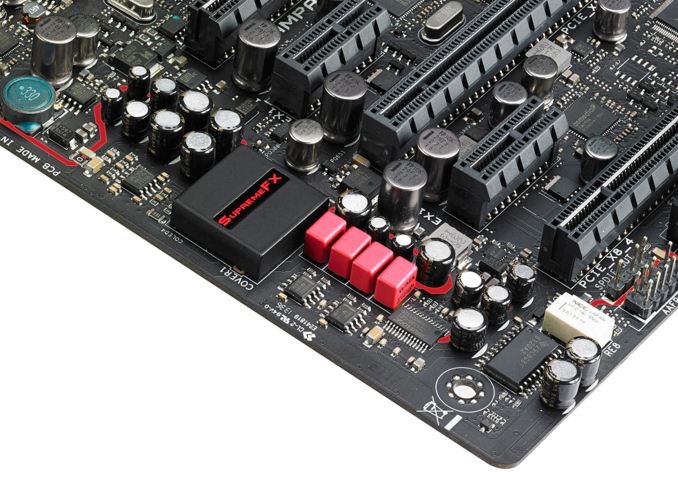
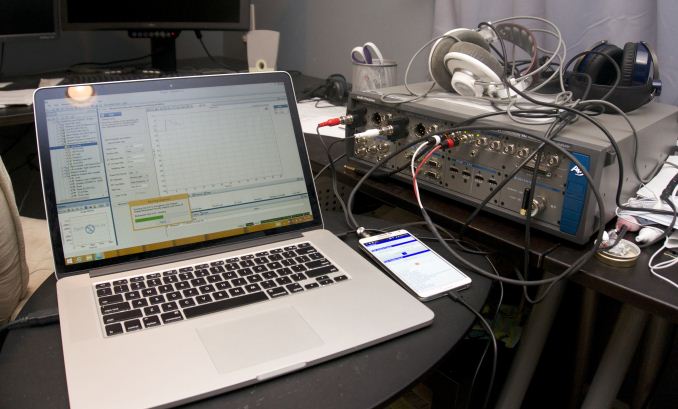

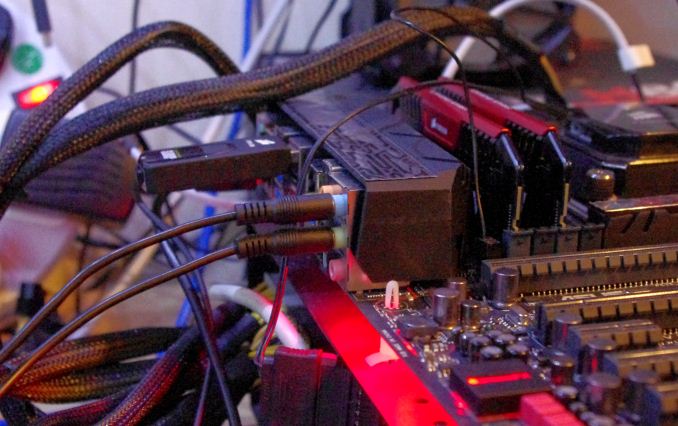
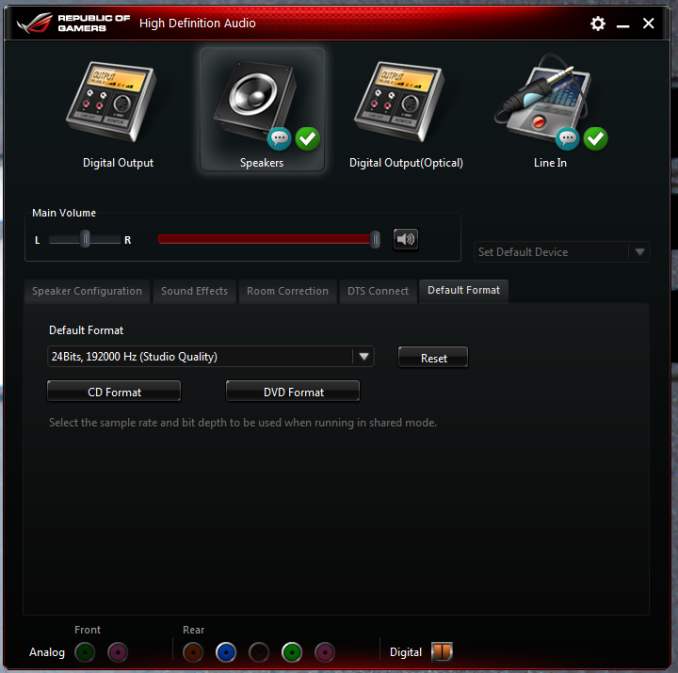








59 Comments
View All Comments
TruePath - Saturday, February 1, 2014 - link
Hmm, the claim in the article is that RM:AA is actually much more sensitive to poor implementations when you use the same hardware for both input and output.In particular, by feeding back the same input into an output on the same device you can sometimes create feedback effects from any signal leakage while detecting the same leakage merely by analyzing the audio out would require a very very sensitive instrument because you've moved the potential interference both closer to the output (EM leakage is more likely from the input that from random computer parts) and can amplify that weakness to a more noticeable size by creating the appropriate kind of feedback in software.
I understood that this was the argument for using the same input and output. Sure, ideally you would have a very sensitive input that lets you directly examine the output for bias (including using feedback) but lacking that you instead choose to increase the pressure on the output by running the most problematic kind of signal right next to it.
thewhat - Friday, January 31, 2014 - link
Also, one thing I noticed with some onboard chips is that they start making noise with CPU/GPU load (sometimes just scrolling in some window), so it might make sense to try to simulate that and see if it affects the results. Perhaps simply running Furmark during the test would do it...ShieTar - Friday, January 31, 2014 - link
See the comment from davidedney above, there is a good likelyhood that you are noticing EM emissions from the CPU/GPU or power supply components connected to it being induced into the analog part of the audio solution. Testing this is far from trivial, as it does not only depend on the Mainboard itself, but also on the type of CPU, GPU and PSU; as well as the case geometry and internal reflectivities for the frequencies in question.kwrzesien - Friday, January 31, 2014 - link
It may be far from trivial, but this is exactly the kind of functional testing I'm looking for in a review here at AnandTech. I want to know if the solution *works* and in what ways - headphones, line out, optical out, front connection on a case (maybe this should be a part of the case tests too). What headphones can I buy that are supposed to work, and do they? Will it hum, crackle or pop? How does it work connected to an AVR?YoshoMasaki - Tuesday, February 4, 2014 - link
Seriously. All I want is to stop hearing random FM radio stations through my dang speakers already :-\Braumin - Friday, January 31, 2014 - link
As a reviewer, I think it's best to stick to the numbers. I think we all appreciate that you are trying to add some additional info to your testing. I think consistent testing is the key if you can't get the absolute top end testing equipment.Audio is a tricky thing for sure, and it has a certain, well let's call them devout group of followers.
Exodite - Friday, January 31, 2014 - link
Thanks for this.I'll add my voice to those who prefer that you stick strictly to numbers, as trying to judge something as nebulous as audio "quality" is bound to backfire.
Justin TenCate - Friday, January 31, 2014 - link
For me, the most important aspects of any PC audio test are noise threshold and audible interference. I can't tell you how annoying it is to spend 20+ hours recording a track to have it mangled and mashed into some unrecognizable combination of squeals, beep, ticks and hisses by cheap MoBo audio on a "premium" board. If I am paying extra for enthusiast gear, I expect the audio to be accurate, distortion and interference free at the very least.sheh - Saturday, February 1, 2014 - link
If you're recording for hours, and mobo quality isn't satisfactory or consistent, just get a standalone or external sound card.Aizen99 - Friday, January 31, 2014 - link
I'd be more interested in you guys exploring sound editing software and text to speech then hardware testing audio chips that have been more then good enough.For instance one of the selling points for me getting Creative soundcards over the competition in ages past was the ability to record audio from wave output. In ages past you couldn't record audio from a wave device that was playing it at the same time internally without resorting to round about methods using the analog out into the mic/line in. It was a royal pain in the butt.